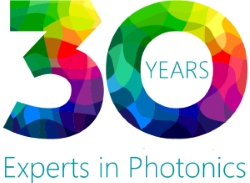FAQ There are no products in this category.
Your questions about laser safety
Everything you always wanted to know about laser safety!
Here you will find answers to your questions about laser safety as well as our extensive range of products for ensuring laser safety in your company!
These abbreviations mean daylight transmission or visible light transmission and represent the value of the daylight transmission still passing through the filter as a percentage.
This value ONLY describes the attenuating effect of the filter and corresponds to the logarithm of ten; in other words, an OD means an attenuation of the optical power by a factor of ten.
In Europe, laser protection goggles can’t just be selected according to this value, since this doesn’t automatically reflect the resistance of the laser safety goggles (which encompasses both the filter glasses and the frame) against laser radiation.
For this reason, only laser safety goggles certified according to EN 207 or 208 may be used, as this is the only guarantee that the entire goggles have the appropriate protection.
D – continuous wave/cw laser
I – pulse lasers with pulse lengths of >10-6 to 0.25 s
R – giant pulse lasers with pulse lengths of >10-9 to 10-6 s
M – mode-coupled lasers with pulse lengths of <10-9 s="" p="">
Unfortunately, it is not possible to determine which laser protective goggles are needed based on the laser class.
The goggle protection levels have nothing to do with the laser classes. These classes only serve as rough points of reference.
In order to be able to determine which kind of laser safety goggles are necessary, the protection level must be calculated using the laser parameters according to the respective DIN standard (207 or 208).
For cw lasers:
Wavelength(s)
Output power
Smallest accessible beam diameter
(If known) beam divergence
For pulsed lasers:
Average power or max. pulse peak power
Max. pulse energy
Min. pulse length
Max. pulse rate
Smallest accessible beam diameter
(If known) beam divergence
The markings on the laser protective goggles are also defined by law. The values for the optical density (OD) must be indicated for the respective wavelength ranges as well as for the protection levels.
An example:
190–535 nm OD 5
190–315 nm D LB5 IR LB3
315–543 nm DIR LB5
The laser safety goggles now have an optical density of 5 (power is reduced by 100,000:1) for the 190–535 nm range, and the protection level LB5 for cw (D for continuous-wave laser) for 190–315 nm and an LB 3 for pulse lasers (I) with pulse lengths between >10-6 and 0.25 s and giant pulse lasers (R) for pulse lengths between >10-9 and 10-6.
For the 315–543 nm range, the protection level for all three categories is LB5.
Laser safety goggles do not always have to be certified for one area; several areas can also be covered by a single pair of laser protection goggles.
Full-protection goggles protect against direct laser impact for 5 s (or 50 pulses). An important precondition is for the required protection level according to EN 207 to be calculated on the basis of the laser parameters.
Full-protection goggles can be used in all wavelength ranges, whereas adjustment goggles are only designed for the visible range. EN 208 is taken as the basis for the calculation of the necessary protection level. As the name implies, adjustment goggles are only intended for laser alignment work and only protect against a direct hit for 0.25 s.
The service life of a pair of laser protection goggles greatly depends on whether or not it receives the proper treatment and care.
Cleaning agents such as water-based cleaning solutions and a soft cloth are recommended for cleaning the googles. Under no circumstances should alkaline cleaning agents, ammonia, or abrasive cloths or solutions be used. Laser protection goggles can be cold-sterilized.
For optimum care, make sure the laser protection goggles are not exposed to any heat sources, and never place the glasses on a surface with the filter side down. Whenever the goggles are not in use, they should be kept in their original case in a cool and dry place.

